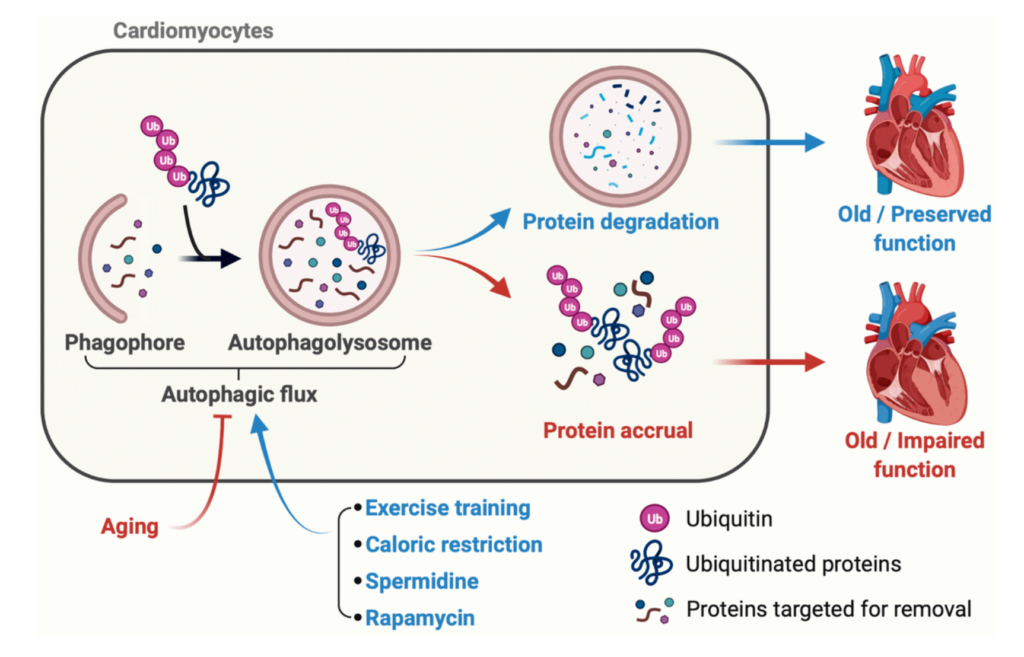In a new research perspective, researchers discuss spermidine, rapamycin, caloric restriction, and exercise training to improve cardiac health in aging individuals.

Cardiac dysfunction is a major public health concern. While it can occur for various reasons at any age, the prevalence of cardiac dysfunction dramatically increases with advancing age. Unfortunately, the underlying mechanisms of age-related cardiac decline are still largely unknown. Thus, it is essential for researchers to uncover novel strategies to improve cardiac health at advanced ages.
Autophagic Flux
An important physiological process involved in maintaining cardiovascular homeostasis is autophagic flux. Autophagic flux is the process by which cells break down and recycle their own cellular components after they have become damaged or unnecessary. This process is essential for maintaining healthy cardiac function, as it slows age-related oxidative damage, reduces the accumulation of toxic lipid and protein aggregates, and improves energy metabolism. However, the efficiency of autophagic flux decreases with age, resulting in declined cardiac function.
Given its crucial role and fading functioning, the search for strategies to improve autophagic flux may be essential for improving cardiovascular health as humans age. Researchers Jae Min Cho, Rajeshwary Ghosh, Sohom Mookherjee, Sihem Boudina, and J. David Symons from the University of Utah authored a new research perspective about nutraceutical, lifestyle and pharmacological interventions that can reduce age-associated cardiac dysfunction. On December 1, 2022, their research perspective was published in Aging’s Volume 14, Issue 23, entitled, “Reduce, Reuse, Recycle, Run ! : 4 Rs to improve cardiac health in advanced age.”
“In the following sections we review evidence that age-associated cardiac dysfunction can be Reduced by boosting cardiomyocyte autophagy (i.e., the ability to Reuse and Recycle damaged/dysfunctional proteins) via spermidine, rapamycin, and caloric-restriction. In addition, we highlight a new report indicating that a physiological intervention i.e., Running, rejuvenates cardiomyocyte autophagic flux to an extent that lessens age-associated cardiac dysfunction.”
Late-in-Life Interventions
Late-in-life interventions to improve cardiac health are particularly important since many of the world’s elderly populations are reaching advanced age with limited resources. This means that proven, inexpensive and accessible interventions to reduce cardiac dysfunction may have a profound impact on these populations. In this research perspective, the authors discuss four key interventions that reduce age-associated cardiac dysfunction: spermidine, rapamycin, caloric restriction, and exercise training. These interventions can reduce age-associated cardiac dysfunction by improving cardiac autophagy.
In October 2021, Cho et al. published a novel research paper about their study on late-in-life treadmill training in mice and its impact on autophagy, protein aggregates and heart function. The results of this study provided the first evidence that late-in-life exercise training can rejuvenate autophagic flux, clear protein aggregates and attenuate aging-associated cardiac dysfunction. In another murine study, researchers demonstrated that calorie restriction activates AMPK and increases the expression of autophagy-associated genes in the heart muscles.
Spermidine is a polyamine found in certain foods, such as legumes and nuts. A 2016 study linked spermidine to reduced age-associated cardiac dysfunction by attenuating cardiac hypertrophy and preserving diastolic function. Rapamycin is an mTOR inhibitor, immunosuppressant and anti-cancer drug. In a 2013 study, Flynn et al. were the first to report the cardiovascular effects of rapamycin in the context of aging. Rapamycin’s cardiovascular benefits include repressed pro-inflammatory signaling in heart muscles, reduced hypertrophy and preserved systolic function.
Conclusion
As the world’s population continues to age, it is increasingly important to identify interventions that can reduce age-associated cardiac dysfunction while avoiding high costs and potential side effects. In this research perspective, the researchers discussed evidence that spermidine, rapamycin, calorie restriction, and exercise training can improve autophagic flux and reduce age-associated cardiac dysfunction. While the mechanisms responsible for these improvements have yet to be fully elucidated, these strategies are cost-effective, accessible and relatively safe for elderly populations, and could provide a valuable way to improve cardiac health in advanced age.
“Findings from Cho et al. suggest that age-associated cardiac dysfunction can be re-established by Reducing (physical inactivity), Reusing (lysosomal degradation products e.g., amino acids for ATP synthesis), Recycling (damaged intracellular organelles via the lysosome and other protein degradation pathways), and Running (or increasing physical activity via any mode that can be enjoyed regularly and safely by the individual) (Figure 1).”
Click here to read the full research perspective published by Aging.
—
Aging is an open-access journal that publishes research papers bi-monthly in all fields of aging research. These papers are available at no cost to readers on Aging-us.com. Open-access journals have the power to benefit humanity from the inside out by rapidly disseminating information that may be freely shared with researchers, colleagues, family, and friends around the world.
For media inquiries, please contact [email protected].